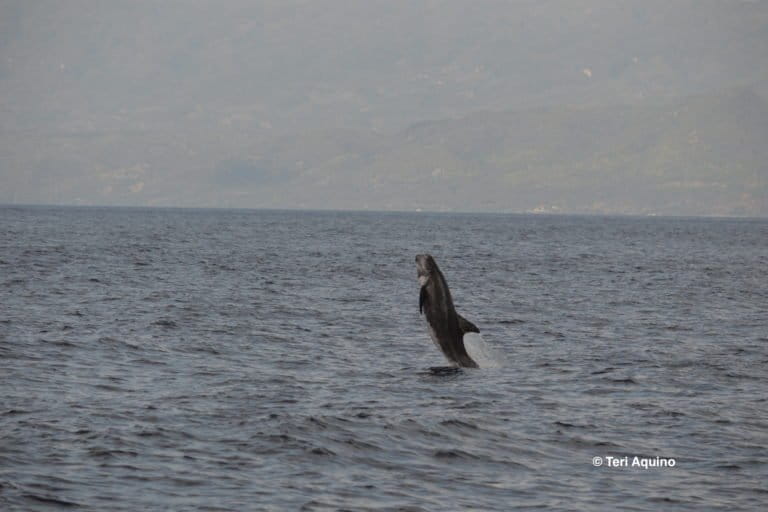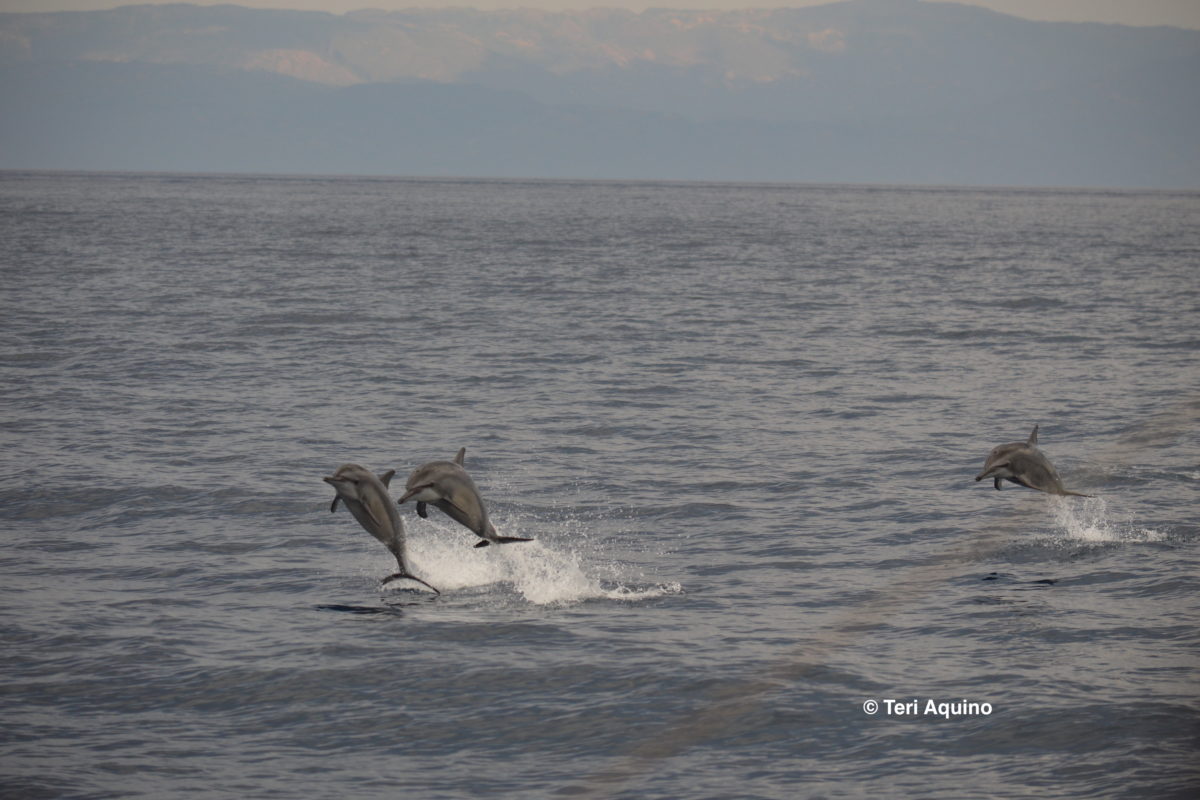- A recent survey has confirmed a declining trend in sightings of dolphins and whales in the Tañon Strait in the central Philippines, a waterway declared an Important Marine Mammal Area by the IUCN.
- The strait is a migratory route for at least 11 cetacean species, including the vulnerable Gray’s spinner dolphin and the endangered false killer whale, but four surveys carried out since 1999 have shown a sharp decline in population and species sightings.
- One bright spot in the latest survey was the sighting of rose-bellied dwarf spinner dolphins, only the second time that the species has ever been spotted in Philippine waters.
- The strait is one of the country’s busiest sea lanes, encountering heavy fishing and tourism activities, which researchers say may be a factor for the downward trend. They call for further collaboration to enact stringent measures on fishing and tourism activities to protect the area.
MANILA — Sightings of dolphins and whales in a Philippine strait long considered an important waterway for the marine mammals have plummeted over the past two decades, with human activity in the area a likely factor, researchers say.
The latest survey of the Tañon Strait, a 161-kilometer (100-mile) narrow body of water between the central Philippine islands of Negros and Cebu, was carried out last year. It found fewer cetaceans, in smaller groups, than surveys conducted in the area since 1999.
Despite the downward trend, a new dolphin species was observed in the area for the first time, highlighting the need for more measures to protect the seascape.
Researchers tallied a new low of just 15 sightings or encounters with six species of dolphins and whales — significantly lower compared to the first comprehensive study done in the marine corridor 20 years earlier.
The survey team recorded sightings of the bottlenose dolphin (Tursiops truncatus), gray’s spinner dolphin (Stenella longirostris), dwarf spinner dolphin (S. l. roseiventris), pantropical spotted dolphin (S. attenuata), Risso’s dolphin (Grampus griseus), and dwarf sperm whale (Kogia sima).

The Tañon Strait is one of the largest marine protected areas in the Philippines and has been a favorite migratory route for at least 11 of the 27 cetacean species found in the country’s waters. It’s also one of the country’s busiest sea lanes, a hotbed of illegal fishing, and a favorite “patrol base“ for security forces cracking down on smuggling activities.
“As an indicator of the health of the strait, your cetacean populations are one of the most visible and sensitive barometers that you can find,” cetacean expert Teri Aquino, who led the survey, tells Mongabay. “What was disturbing for me was that all three surveys from 2003 to 2019 were nowhere near the counts or encounter rates of 1999.”
The 1999 study recorded 81 marine mammal observations along a series of paths, or transects, running a combined 434 km (270 mi) within the strait. This figure became the baseline for future surveys, carried out in 2003, 2008, and most recently in May 2019. Aquino then compared the results of the 2019 survey to the earlier ones to establish a trend.
What she found was a consistent, declining trend. The 2003 survey yielded 15 encounters with four species covering transects of 321 km (200 mi), while the 2008 survey showed 23 sightings along a nearly identical survey path, and also observed just four species.
The 2019 results yielded 15 sightings along a 202.76-km (126-mi) path — the smallest coverage compared to previous studies — but spotted six species, including two pods of rose-bellied dwarf spinner dolphins, a subspecies of the spinner. This was a species never before spotted in the Tañon Strait, and only seen once before in Philippine waters, in the Balabac Strait off the southern tip of Palawan Island in 2006. “To date, this is only the second site in the country which has recorded the presence of this subspecies,” the survey says.
Aquino attributes the smaller survey area this time around to erratic weather. The team encountered three tropical cyclones during the survey, which forced them to end it after four days, or just 18 and a half hours on the water. And while they only covered 10 lines of the target 17 transects, Aquino says the “results were still significant,” as the weather pattern could drive lower sightings and increase stranding incidences. She also says she has never before encountered successive storms in the middle of summer, the peak season for dolphin and whale visits in the area. “The changing weather conditions will definitely have a detrimental effect on the cetacean population in Tañon if it hasn’t already,” she says.

Changing species composition
Gray’s spinner dolphins and dwarf sperm whales remain the dominant cetacean species in Tañon, but now occur in lower numbers and smaller groups. Other species have come and gone since 1999.
Highly sound-sensitive whales like the short-finned pilot whale (Globicephala macrorhynchus) and the melon-headed whale (Peponocephala electra) were encountered three times in 1999, but have not been spotted since. Aquino says oil exploration activities carried out from 2003 to 2008 could have triggered their disappearance.
Meanwhile, the Risso’s dolphin was not seen in the 1999 survey but has been consistently recorded in Tañon from 2003 onward. The bottlenose dolphin, recorded in the 1999 study, went missing in the 2003 survey but showed up again in 2008 and 2019.
“What does this mean exactly?” Aquino says. “I can only speculate that the strait may not have as much of the prey that these species like to eat enough to entice them.” She adds that cetacean species with large organs for echolocation may find the strait too narrow and constricting for them to hunt in.
Aside from the availability of food, possible habitat disruption by marine traffic may be deterring these species from venturing into the strait, Aquino says. “Unlike large cetaceans such as the humpback whale, small cetaceans don’t have specific calving habitats that drive them to migrate,” she says. “The abundance and availability of their food would likely keep them coming back to an area. Threats or disturbance to that habitat would drive them away.”

The 2019 survey recorded 101 marine vessels plying the strait. Nearly half were small outrigger vessels for ferrying passengers, and most of the rest were small fishing boats commonly used in dolphin-sighting tours.
Dolphins are a major tourist draw for the area, but the survey found that in some cases such boat tours could be chasing away the marine mammals. During the survey, the researchers observed five dolphin boats crowd a pair of bottlenose dolphins, causing them to flee.
“The quality of dolphin watching interactions were also adversely affected and this could be bad for business,” the survey said. “It would be interesting to note how the growing tourism activities in the area would impact the reef and, therefore, this subspecies. If not managed properly, the tourism in the area could cause damage to the shallow reefs and drive these animals to abandon the area.”
‘More collaboration’
Tañon’s “considerably high diversity of cetaceans despite its relatively small area” was a pleasant surprise for researchers conducting a nationwide survey of marine mammal sightings in 1992. That study was supplemented by a 1995 paper that shone a spotlight on Tañon, which at the time was experiencing massive illegal fishing activities, which prompted then-President Fidel Ramos to declare it a marine protected area in 1998. By 2018, the strait was designated an Important Marine Mammal Area (IMMA) by the IUCN.
But despite more than two decades as a protected area, Tañon is still far from stable, Aquino says. “The main challenge for managers of any protected area is always how to balance protection of a species or their natural habitat with the needs and demands of the community living in and around it.”
Its sheer size poses challenges for its management, but also opens more room for collaboration, says Yasmin Arquiza of Rare Philippines, the conservation NGO that supported the Tañon Strait Protected Seascape authority in the latest survey. One promising avenue for communities and conservationists to work together is in the fight against illegal fishing.

“Intrusion of commercial fishing vessels inside municipal waters is still the main problem that coastal communities continue to face, despite enhanced law enforcement and fisher registration efforts,” Arquiza says. “There’s still much room for collaboration between national agencies and local governments in regulating tourism, protecting marine life, and keeping commercial fishing out of the protected area.”
Similarly, the study recommended systematizing and regularly conducting surveys and assessments of marine mammals in Tañon to effectively streamline conservation efforts on the ground — a recommendation that Aquino says the Tañon Strait Protected Seascape governing body is looking at implementing.
“I think possessing more information about what you’re trying to protect gives you a better idea on how you can do the tightrope more effectively,” Aquino says. “There are still gaps in research (monitoring and establishing baselines) and communications as well as regulations and enforcement efforts.”
Citations:
Leatherwood, S., Dolar, M. L. L., Wood, C. J., Aragones, L. V., & Hill, C. L. (1992). Marine mammal species confirmed from Philippine waters. Silliman Journal, 36(1), 65-86.
Dolar, M. L. L., Perrin, W. F., Taylor, B. L., Kooyman, G. L., & Alava, M. N. R. (2006). Abundance and distributional ecology of cetaceans in the central Philippines. Journal of Cetacean Research and Management, 8(1), 93-111.
Perrin, W. F., Aquino, M. T., Dolar, M. L. L., & Alava, M. N. R. (2007). External appearance of the dwarf spinner dolphin (Stenella longirostris roseiventris). Marine Mammal Science, 23(2), 464-467. doi:10.1111/j.1748-7692.2007.00117.x
Banner image of three Gray’s spinner dolphins (Stenella longirostris) photographed during the May 2019 marine mammal survey in Tañon Strait. Image by Teri Aquino.
FEEDBACK: Use this form to send a message to the author of this post. If you want to post a public comment, you can do that at the bottom of the page.
